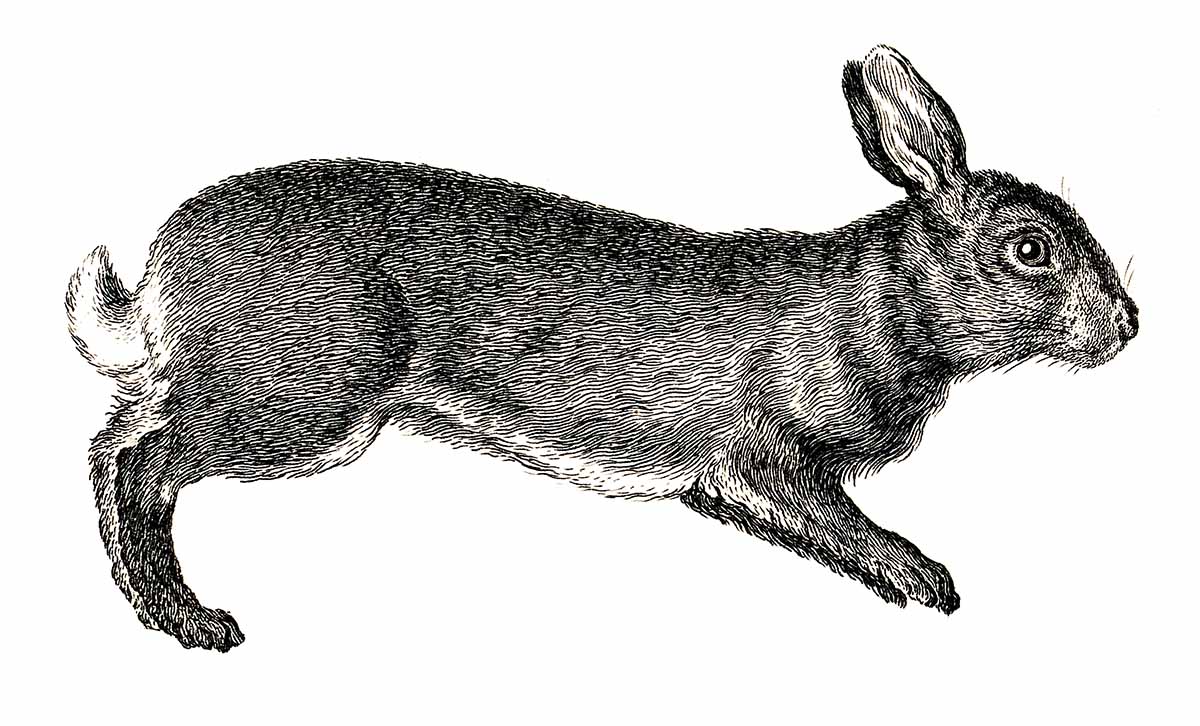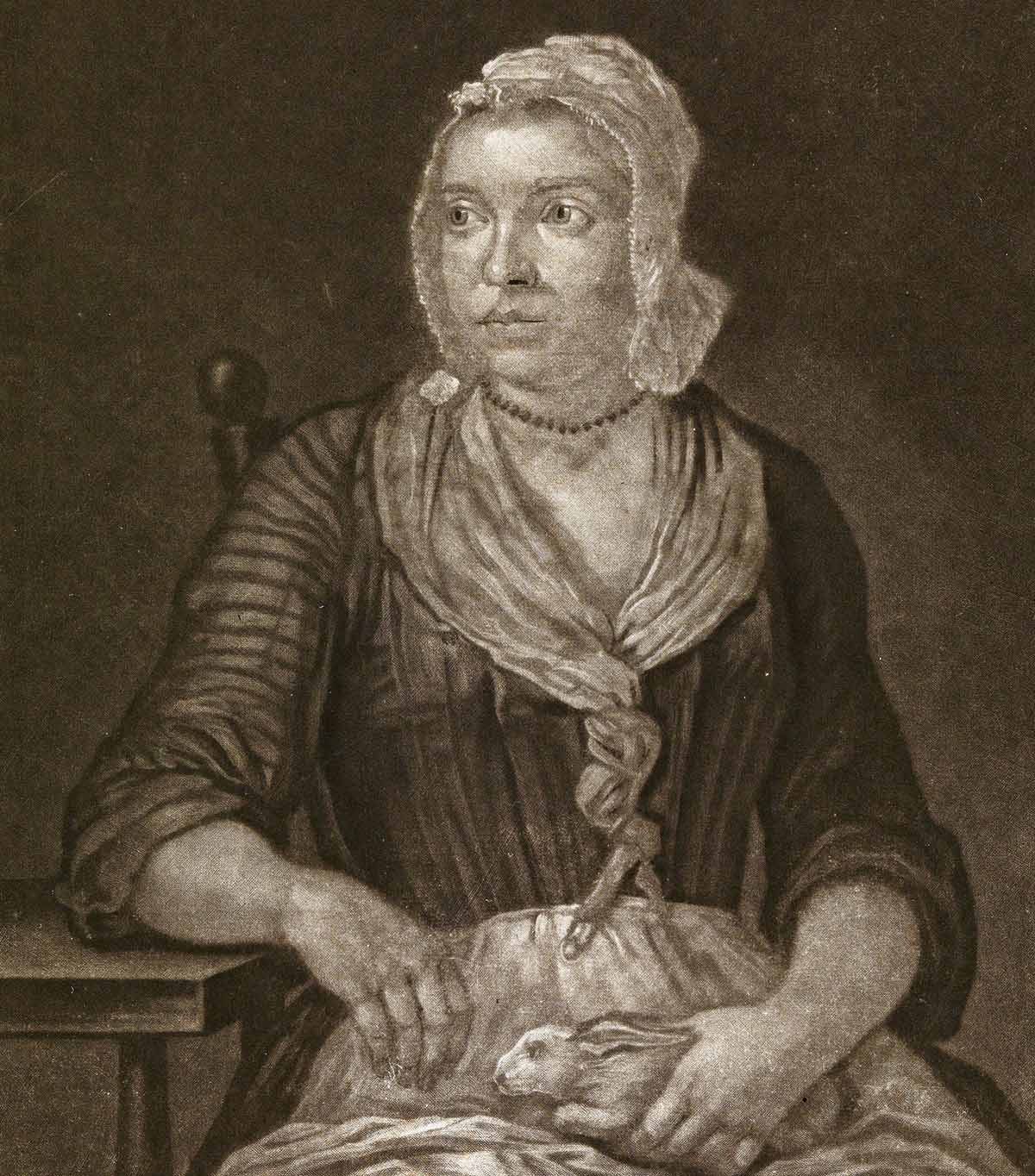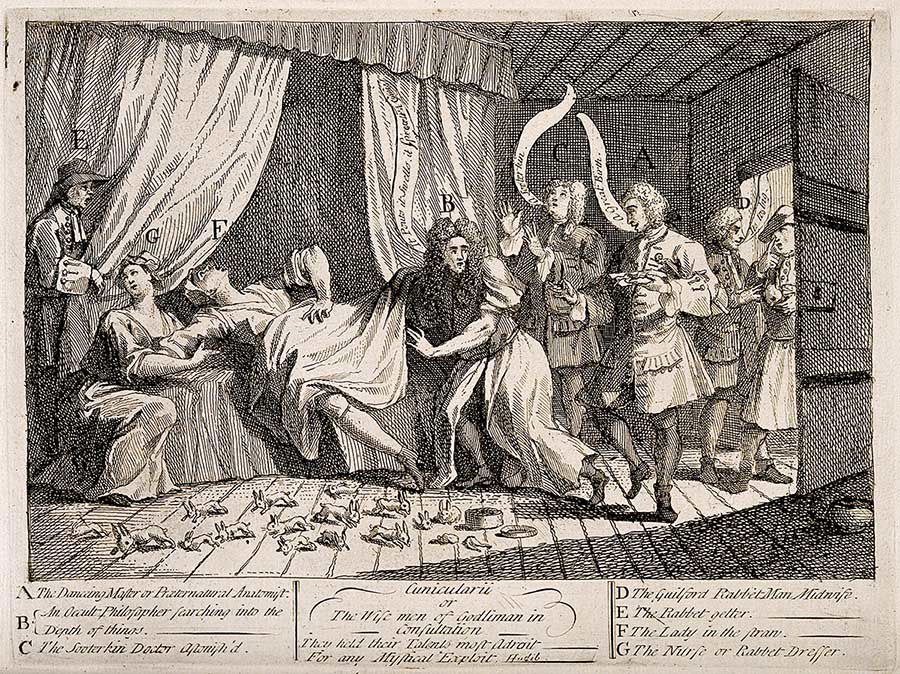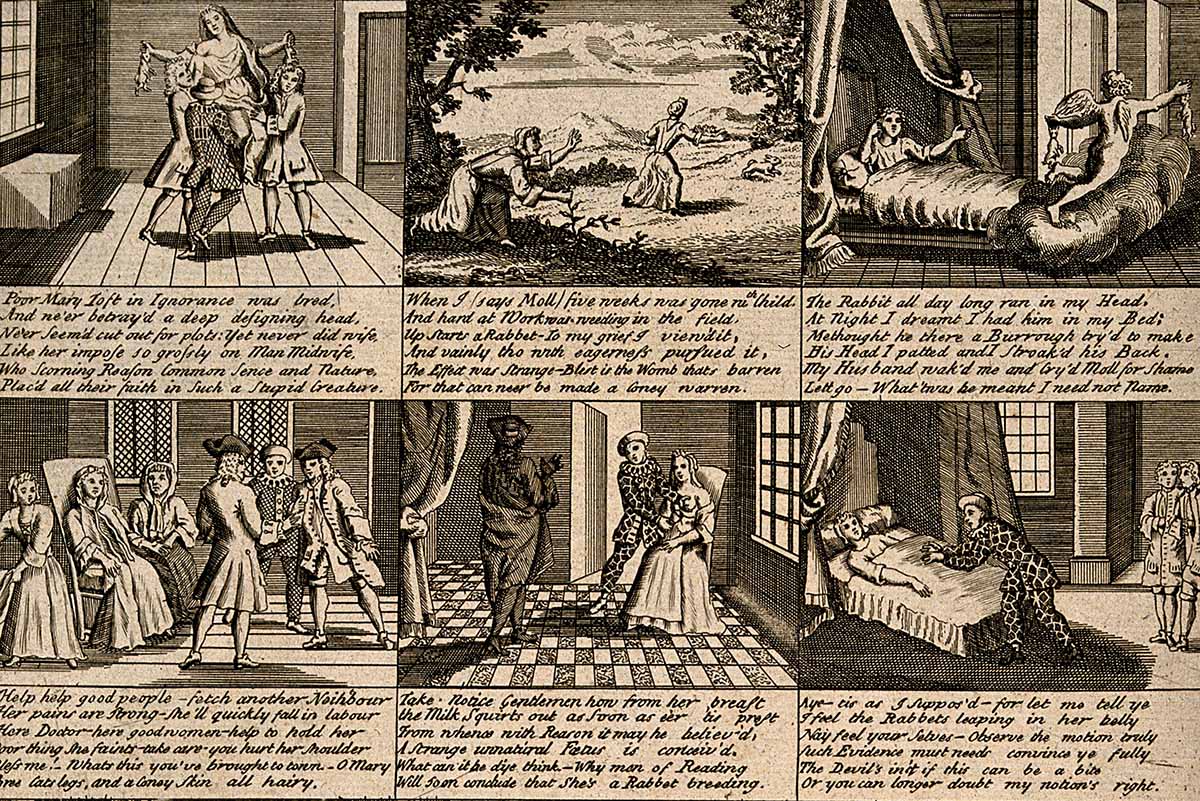The Great Rabbit Hoax | History Today - 15 minutes read

On a Friday two weeks before Christmas 1726 news reached Exeter of a curious theatrical performance which had taken place in London the previous Saturday night, on 10 December. An Exeter newspaper reported that, at the end of the main play at the Lincoln’s Inn Fields theatre, the audience witnessed an unexpected short entertainment called ‘Harlequin the Sorcerer’:
Harlequin, assisted by a Man Midwife, was delivered of 4 Rabbits, which ran about the Stage, and raised such a Laughter as perhaps has not been heard upon any other Occasion.
Whether these four rabbits were played by actors in costumes, took the form of some kind of model or puppet, or were actual living animals skipping about the London stage was not entirely clear from the report. But the hilarity of the audience was palpable: this performance of a sorcerer giving birth to rabbits provoked perhaps the loudest laughter ever to be heard in a London theatre.
Everyone at that performance understood the joke. London had been captivated by rabbit births since October, when a newspaper reported that three women working in a field in Surrey had chased a rabbit:
One of the Women has since, by the help of a Man Midwife, been delivered of something in the Form of a dissected Rabit.
Newspaper reports quickly became ever more detailed: the ‘poor Woman’ lived in Godalming, near Guildford, and was married with two children; the midwife was the ‘eminent’ John Howard and he was in contact with the Royal Society to discuss this ‘strange but well attested piece of News’. Several rabbit parts continued to appear but, during keen investigation by several doctors and other learned men, doubts emerged. By early December, the British Journal scoffed, ‘A fine Story!’ The hoax was revealed on 5 December, followed fast by Harlequin’s rabbit births on the stage at Lincoln’s Inn Fields. As the Exeter report made clear, the theatrical performance was ‘a Representation ridiculing the aforesaid Imposture’. But it also ridiculed those who had believed in the rabbit births in the first place. The play was part of a wave of print, poems and engravings that relished the evident absurdity of a woman giving birth to rabbits, as well as the credulity of the group of learned men who believed that she had.
Women’s imaginations
The woman at the centre of this affair was Mary Toft. Born in 1703, Mary Denyer was 17 when she married the 18-year-old Joshua Toft. She had already given birth to two children: Ann had died the year she was born but James was aged two and Mary was pregnant with a third child when the rabbit births began in 1726. Like other poor women, Mary made shift with seasonal agricultural work and, according to her testimony, the rabbit birth affair was triggered as she was weeding in a field. In several accounts, Mary explained that she had been pregnant when she saw and chased a rabbit that got away. She continued to think about the rabbit until, a short while later, she started to bleed and pass unidentified and fleshy parts. Toft appears to have experienced a prolonged and painful miscarriage and her account of this is moving and unique. It was only some time after this miscarriage that the rabbit parts began to appear. Her account – that something she had seen, desired but failed to capture had disrupted the normal course of a pregnancy and transformed the form of the unborn child within her – made the entire story both believable and captivating. Toft knew that this account might convince her audience. Later questioned about the affair, she began her first statement: ‘I was delivered of a true monstrous birth.’

An ancient medical theory, found in the works of Aristotle, Galen and Pliny, supposed that what a woman saw or felt when pregnant might make a literal impression on her mind, and that this could be imprinted upon her foetus. In the case of Mary Toft, the process was still going on. Her repeated rabbit births looked like the first live evidence that the pregnant woman’s imagination was so powerful as to transform a human foetus into a monster. As Nathaniel St André, the Swiss émigré doctor and surgeon and anatomist to George I’s Royal Household, put it, he visited Toft in order to be, ‘convinced personally of a Fact of which there was no Instance in Nature’. He meticulously described his findings in his pamphlet account, in which he was sure to separate himself from those ‘flying Reports and Conjectures’ already circulating. Here in Surrey, the classical theory of the maternal imagination appeared to have moved from hypothesis to observable scientific fact.
Scrupulous examination
The chance of a live performance of a monstrous birth generated considerable urgency; a steady stream of highly regarded doctors flowed to see Toft in Guildford. There they each witnessed deliveries of real animal parts. St André was there for the birth of the skinned torso of a rabbit, with the heart and lungs still intact. Cyriacus Ahlers, a German surgeon attached to George I’s German household, delivered the hind part of a skinned rabbit which bore both flesh and bones. Hearing reports of this, the physician and midwife Richard Manningham, who had been knighted in 1722, stayed up until the early hours waiting for his companion to take him to Guildford so he could see for himself. Manningham delivered a piece that he subsequently described as ‘like a piece of Hog’s Bladder’. Instead of immediately declaring the affair a fraud, he placed the piece between the pages of his pocket book and took it to London, where he would later show his fellow doctors. One of these men was James Douglas, a Scottish anatomist, midwife and member of the Royal College of Physicians. Douglas was to receive a note about the case from St André, written at midnight on 29 November:
I have brought the Woman from Guildford to the Bagnio in Leicester fields. She now has a Live Rabbit in her and I Expect shortly a Delivery: you will infinitely oblige me to deliver her your Self.
Douglas responded immediately and would arrive at the bagnio shortly afterwards.
Empirical observation, a hallmark of early modern science, was a principal tool of these doctors. The signs of pregnancy in Mary’s body were carefully scrutinised. A white substance emitting from her breast was checked to see if she was lactating. The animal parts that were taken from her body were tested to assess whether they had gestated within her body or had been placed there by human hand. Her swollen belly was examined and she underwent several vaginal examinations. The efforts undertaken by these men suggest that they took seriously the possibility of a monstrous birth.
It is striking, then, that none of the doctors discussed the theory of the maternal imagination as the cause of what they witnessed. Most were highly cautious and sceptical throughout. In his book, written after the hoax was exposed, Ahlers was careful to proclaim that he was the first doctor whose suspicions were aroused in Guildford. Nonetheless, the book closed with his five-page ‘Anatomical Description of the several Parts of the Sixteenth Rabbet’, which he took to show the king. Manningham retrospectively claimed that he had always suspected fraud, though he, too, took that supposed hog’s bladder back to London for verification.
The considerable efforts of these doctors can be explained partly by professional ambition. If this was a case of a genuine monstrous birth, they each wanted to be involved. This clearly drove St André, who, in claiming to several correspondents – including Sir Hans Sloane, president of the Royal College of Physicians and secretary of the Royal Society – that he had brought Mary Toft to London, sought out professional esteem and better connections. In turn, each of the doctors entered the newly dynamic 18th-century public sphere through print, making their case, giving their judgement and establishing their public status.

More important than the opportunity for professional advancement was the occupation of scientific enquiry. The strenuous efforts at investigation by these doctors showed not that they believed Toft, but instead that they were so committed to scientific examination of the available evidence that they would only denounce the monstrous births with certain proof. As James Douglas commented of his own motivation in investigating the case, his aim was:
to come at a speedy Discovery of the Imposture, by plain, sensible, and undeniable Facts, of which all the World might be Judges, and not Physicians and Anatomists only, who were capable of determining the Matter upon other Principles.
In Guildford and then in London, a group of trained medical men and respectable gentleman scholars debated the evidence before them. The rooms of the bagnio were put to good use, with Mary kept in a lodging room while the men would gather in the nearby dining room to view some of the animal parts. Historians have often viewed Mary Toft’s monstrous births as an example of the credulity of early-18th-century doctors and their ill-informed theories about conception and reproduction. Yet most of their efforts were not intended to uncover the truth of the monstrous births. Instead, in the context of the Scientific Revolution and the burgeoning medical fields on reproduction and foetal development, they went to considerable lengths to discern the limits of falsehood. Their treatment of Toft was disdainful and often cruel, but their attempts at scrupulous investigation exemplify the development of medical practice.
Royal curiosity
News of the case had reached the Royal Court by the middle of November. St André was accompanied to Guildford on 15 November by Samuel Molyneux, secretary to the Prince of Wales. Ahlers arrived in Guildford on 20 November at the behest, he wrote, of the king himself. He would return to show him the rabbit parts. St André, who claimed to have written to Richard Manningham on the suggestion of the king, also suggested that he had displayed animal parts to His Majesty. George I examining those that had exited Mary Toft’s body is one of the most remarkable scenes of this whole affair. This royal curiosity was most likely what propelled Mary Toft from Guildford to London. When, late on 29 November, Mary Toft was brought to the Leicester Square bagnio, one newspaper reported that this was ‘by Order of his Majesty’. The king’s stake in the affair was thus publicly declared. As long as Mary Toft went on producing rabbits, this was a legitimate interest in something that was potentially medically groundbreaking. But, if the rabbit births were revealed to be nothing more than a trick, this royal interest risked appearing faintly ridiculous. Just days after the king had supposedly brought Mary Toft to London, the porter at the bagnio reported that her family had asked him to smuggle in dead rabbits through the back door. The case in which George I had made a very public investment promptly crumbled.
The hoax will out
Initial interest in the case was driven by curiosity, professional ambition and medical enquiry among the doctors. When it was revealed that the rabbits were not a genuine monstrous birth, though, different questions were raised. If Mary Toft had not gestated rabbits, then what had happened and why? Efforts to uncover the truth of the hoax redoubled. Press interest intensified and the tone of the reports changed. If Mary Toft had once been described as the ‘poor’ woman, she now became a ‘wicked’ woman. She was taken into custody, aggressively questioned and subject to a criminal prosecution against her and the Guildford doctor, John Howard. Over night the case transformed from a medical to a political affair. Though the evidence does not show who initiated the prosecution, it is clear that those in positions of power – representatives of the state and the monarchy – were the protagonists.
One of the outstanding puzzles of the affair is why Mary Toft was subject to a criminal prosecution. Toft was accused of an ‘Abominable Cheat & Imposture’. In other words, she was prosecuted for pretending to have given birth to rabbits.
Yet no one had been defrauded of any money and no one – save the rabbits – had been harmed. A prosecution in the Westminster Quarter Sessions seems to be the proverbial sledgehammer to crack a nut. The public embarrassment of the king was surely one important factor and there is evidence that the man who prosecuted the case – the MP Thomas Clarges – was directly instructed by the king. But Clarges did not work alone; he was flanked by several men with government posts, royal court positions and active involvement in the criminal justice system. In acting against Mary Toft, these men were shoring up their authority at precisely the moment that it appeared to be under attack.

Mary Toft’s rabbits linked her directly to perceived threats to authority in the early 18th century, among them longstanding protests on the property of wealthy landowners. During the 1720s, direct social conflict had emerged within royal forests, originating in the area around the county borders between Berkshire, Hampshire and Surrey. Known to contemporaries as the ‘Blacks’ because they acted in disguise, often by blackening their faces, these groups damaged or stole property, including buildings and animals. Deer were a common target for these poachers, though other animals such as fish were also taken. Rabbits had been a focus for several protests: escaping from their warrens to wreck the land and livelihood of nearby tenants and freeholders, rabbits became a symbol of the exploitative and unchecked power of the landed elite. Rabbits were also a focus for social tensions because, as the prices of wool and grain declined between 1660 and 1750, rabbit farming had replaced dairy and arable farming in the sandy areas suited to warrens. The decline of the clothing trade in some areas went hand in hand with the growth of commercial warrening.
Godalming, Mary Toft’s home town, stood at the heart of this area. It was a particularly poor area of Surrey and had been damaged by the depression in the clothing industry. Though it escaped the protests seen in other places, there is evidence that the wider political unrest reached Godalming. Mary Toft’s husband, Joshua, was an unskilled clothworker. In the summer of 1726, he appeared at the Surrey Quarter Sessions alongside 37 other men charged ‘for a trespass in entering the ground or pond of James Stringer … with an intent to steale fish’. As Joshua Toft was facing prosecution for trespass and an attempt to steal fish, his wife was preparing to give birth to rabbits. Within a few short months, husband and wife had each been brought before the courts for disruptive and provocative behaviour that centred on problematic animals.
Perhaps the most unsettling of the couple was the woman whose force of mind had allowed her to use her own body to mysteriously produce those animals. Suspicions about women’s unbounded desire and unruly bodies underpinned the theory of the maternal imagination. The harsh treatment meted out to Toft by the stream of male doctors and elite observers also sprang partly from an undercurrent of misogyny, as did the vitriolic press coverage. Mary Toft represented not just potential unrest on the part of the poor but a potential threat to the social order: the conscious actions of a thinking woman.
Performance
By the time that Harlequin the Sorcerer took to the boards to deliver his rabbits, Mary Toft had been denigrated for her own fraudulent performance. Whether or not she had any choice in playing this role is difficult to judge. We do know that the performance was watched by crowds of people. The evidence describes the original scene in her home town of Godalming as one busy with family and neighbours, particularly women. Moved to nearby Guildford, ‘most of the People’ came to see her installed in the building of the local doctor, John Howard. While in the Leicester Square bagnio in London, not only was she kept under constant surveillance by the doctors and visited by a stream of prominent men investigating the case, it was reported that ‘Every creature in town, both men and women’ came to look. Finally, once incarcerated in the Westminster house of correction and awaiting the outcome of the criminal prosecution against her, one newspaper reported on ‘the infinite Crowds of People that resort to see her’.
Vicious prurience characterised this public fascination. And there is no doubt that this alone could sell newspapers. Yet the evidence suggests something even more sinister. Public opinion was being manipulated by those behind the prosecution. In the end, the public and the prosecutors were thwarted; the criminal case against both Mary Toft and John Howard was dropped because no criminal act could be proven. Marginal and lacking in formal power due to both her social position and gender, Mary Toft was nevertheless a profoundly unsettling figure for those who wished to preserve the early 18th-century status quo.
Karen Harvey is Professor of Cultural History at the University of Birmingham. Her latest book is The Imposteress Rabbit-Breeder: Mary Toft and Eighteenth-Century England (Oxford University Press, 2020).